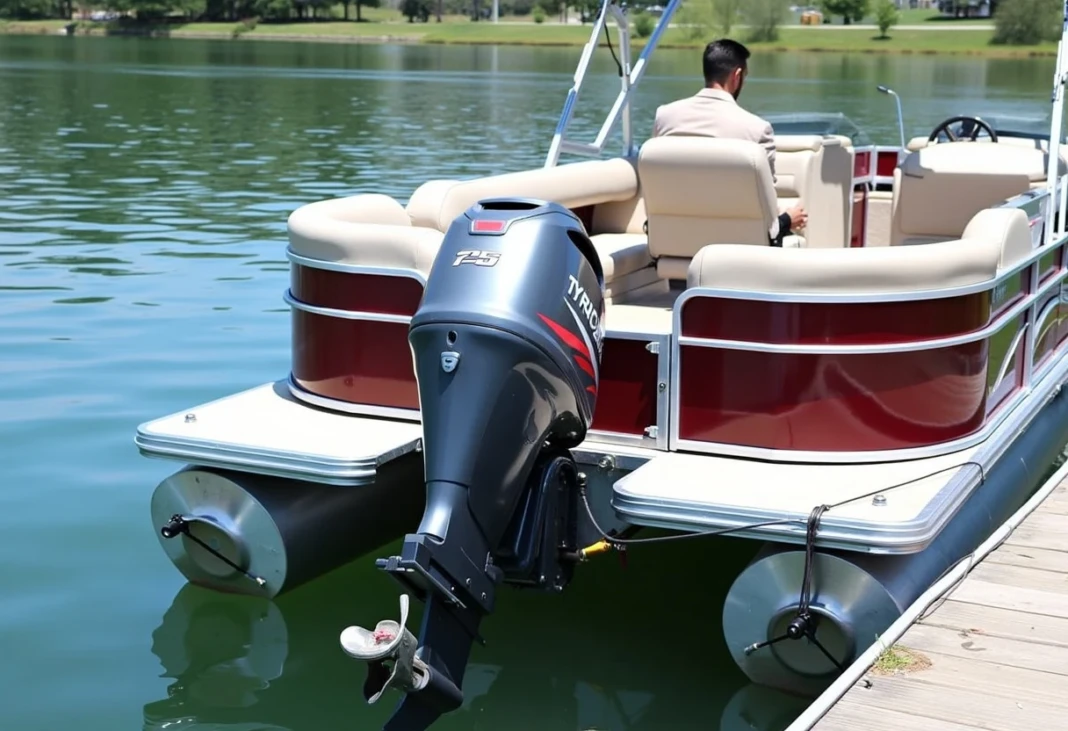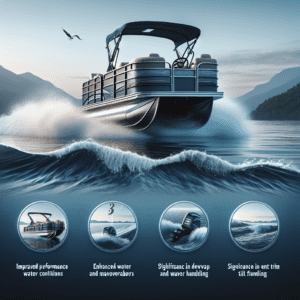Shaft Length for Pontoon Boats
Pontoon boats come in all shapes and sizes, but one crucial factor that influences their performance is the shaft length of the motor. The shaft length refers to the distance between the motor and the boat’s transom, and it can impact everything from maneuverability to fuel efficiency.
Correct Shaft Length
Choosing the appropriate shaft length for your pontoon boat is essential to ensure optimal performance on the water. A shaft that is too short can cause cavitation, decreased performance, and potential damage to the motor, while a shaft that is too long can cause drag, reduced fuel efficiency, and increased weight.
Newport NV-Series 86lb Thrust Transom Mounted Saltwater Electric Trolling Motor with LED Battery Indicator (36" Shaft)
Difference Between Shaft Lengths: 20”, 25”, and 30”
- 20” shaft: Suitable for lightweight pontoon boats with small motors and shallow water conditions.
- 25” shaft: Optimal for medium to large-sized pontoon boats with relatively deep water and moderate wave conditions.
- 30” shaft: Ideal for heavy-duty pontoon boats with high-powered motors and deep water conditions.
How to Measure Your Pontoon’s Shaft Length Requirement
Accurately measuring your pontoon’s shaft length is crucial to ensure you choose the right motor for your boating needs. You can measure your shaft length by measuring the distance from the transom to the waterline and adding 6 inches. Alternatively, you can measure from the transom to the top of the hull, and the resulting measurement will be the appropriate shaft length.
The Benefits of a 25” Shaft on Your Pontoon Boat
Improved Performance in Varied Water Conditions
A 25” Shaft on your pontoon boat can result in improved performance in varied water conditions. With a longer shaft, your boat will have better maneuverability and stability. This means that you will be able to navigate through choppy waters with ease. Additionally, the longer shaft will also help your boat stay on plane at lower speeds, which can increase fuel efficiency.
Enhanced Control and Maneuverability
The longer shaft of a 25” Shaft motor can also lead to enhanced control and maneuverability. With a longer shaft, you will be able to make tighter turns and navigate through tricky situations more confidently. Additionally, you will have more control over your boat in rough waters, which can lead to a safer and more enjoyable ride.
Importance for Deep Water and Wave Handling
If you plan on using your pontoon boat in deep water or in areas with large waves, a 25” Shaft can be especially important. With a longer shaft, your boat will be able to handle larger waves and choppy conditions more effectively. This can provide a smoother and more enjoyable ride, even in rough conditions. Additionally, the longer shaft can increase the distance between the motor and the water, which can help prevent damage to the motor in shallow areas.
Impact on Engine Trim and Tilt Features
A 25” Shaft can also impact the engine trim and tilt features of your pontoon boat. With a longer shaft, you will have greater control over the angle and position of your motor, which can help you optimize performance and fuel efficiency. Additionally, the longer shaft can help prevent cavitation, which occurs when air bubbles form around the propeller and can cause damage to the motor.
In conclusion, a 25” Shaft can offer a range of benefits for pontoon boat owners. From enhanced performance and maneuverability to increased control and stability, a longer shaft can lead to a safer and more enjoyable boating experience. Additionally, a 25” Shaft can be particularly important for deep water and wave handling, and can optimize engine trim and tilt features. If you are considering a new motor for your pontoon boat, be sure to take these factors into account when selecting the right shaft length for your needs.
Selecting the Right 25” Shaft for Your Needs
When selecting a 25” shaft for your pontoon boat, there are certain considerations to keep in mind. In this section, we will explore the different types of motors compatible with 25” shafts, material considerations, brand comparisons and reviews, and propeller compatibility.
Types of Motors Compatible With 25” Shafts
Not all motors are compatible with 25” shafts. It is important to ensure that the motor you select is compatible with your pontoon boat. The most common motor types that are compatible with 25” shafts are outboard motors. When selecting an outboard motor, make sure it is the right size for your boat.
Material Considerations: Aluminum vs. Stainless Steel
25” shafts are available in both aluminum and stainless steel material. Stainless steel shafts are more durable and can withstand harsh environments for longer periods of time. However, they are more expensive than aluminum shafts. Aluminum shafts are less expensive and more lightweight than stainless steel shafts. If your pontoon boat is used in calm waters, an aluminum shaft may be sufficient.
Brand Comparisons and Reviews
There are many brands that offer 25” shafts for pontoon boats. It is important to research and compare different brands to ensure you are getting the best quality and value for your money. Reviews from other pontoon boat owners can also give valuable insight into the performance and reliability of different brands.
Propeller Compatibility with 25” Shafts
The propeller is an important component in the performance of a pontoon boat. When selecting a 25” shaft, it is important to ensure that the propeller is compatible with the shaft size and motor type. This will ensure that your pontoon boat operates at optimal performance.
In summary, selecting the right 25” shaft for your pontoon boat requires consideration of motor type, material, brand, and propeller compatibility. Research and comparison of different options can ensure the best quality and value for your investment.
Installation Insights for 25” Shaft Motors on Pontoons
Professional Installation vs. DIY: What You Should Know
When it comes to installing a 25” shaft motor on your pontoon boat, you have two options: professional installation or DIY. While DIY may seem like the cheaper option, it’s important to consider the expertise required to complete the installation properly. A professional installation ensures that everything is done correctly in terms of compatibility and safety.
Additionally, many motor manufacturers require a professional installation to honor the warranty. However, if you have experience with mechanical components and feel confident in your abilities, you can save money by installing the motor yourself. Just make sure to follow the manufacturer’s instructions and take note of any special tools or equipment required.
Step-by-Step Guide to Installing a 25” Shaft Motor
If you decide to proceed with a DIY installation, here are the general steps involved:
- Remove the old motor and any components attached to it.
- Install the new motor onto the mounting bracket using the manufacturer’s instructions.
- Connect all electrical components, including the battery, wiring harness, and control cables.
- Add oil and any necessary fluids.
- Test the motor in a controlled setting before taking it out on the water.
Common Installation Challenges and Solutions
While installing a 25” shaft motor on your pontoon boat is a straightforward process, there are a few common challenges that you may encounter. The most significant challenge is ensuring that the motor is compatible with your boat’s transom and steering system. Make sure to check the manufacturer’s recommendations regarding shaft length and motor weight capacity to avoid any issues.
Another challenge is correctly adjusting the height of the motor on the transom. Make sure that the motor is not too high or too low, as this can impact its performance and efficiency. You may need to adjust the trim angle and tilt features of the motor until you find the optimal setting for your boat’s needs.
Maintenance Tips for Longevity and Reliability
Proper maintenance is key to ensuring that your 25” shaft motor lasts as long as possible and performs optimally throughout its lifespan. Make sure to follow the manufacturer’s maintenance schedule, which may include regular oil changes, filter replacements, and lubrication of moving parts.
It’s also a good idea to regularly inspect the motor for any signs of wear and tear or damage. Check for loose bolts or connections, as these can cause significant issues if left unaddressed. Additionally, make sure to keep the motor clean and dry when not in use to prevent corrosion or other damage.
| Data Point | Summary |
|---|---|
| Installation Options | Professional Installation and DIY |
| Benefits of Professional Installation | Ensures compatibility and safety; may be required for warranty |
| General Steps for DIY Installation | Remove old motor; install new motor; connect electrical components; add necessary fluids; test |
| Common Installation Challenges | Compatibility with transom and steering system; adjusting motor height |
| Maintenance Tips | Follow manufacturer’s maintenance schedule; inspect for wear and tear; keep motor clean and dry |
Real-World Applications and Case Studies
If you’re still not convinced that a 25” shaft is the way to go for your pontoon boat, take a look at some real-world applications and case studies.
User Experiences with 25” Shafts on Pontoons
Many pontoon boat owners swear by a 25” shaft, citing improved performance, maneuverability, and ease of handling. One owner noted that their 25” shaft made a significant difference in rough water, allowing them to maintain control and speed even in choppy conditions. Another user reported enhanced stability and better acceleration with a 25” shaft.
Case Studies: Performance Improvement Examples
A study conducted by a major pontoon boat manufacturer found that a 25” shaft improved speed and fuel efficiency compared to a 20” shaft. The same study reported that a 25” shaft provided better handling and reduced bow rise during acceleration.
Q&A: Experts Answer Your Most Common Questions
Q: Is a 25” shaft suitable for all pontoon boats?
A: No, it’s important to measure your pontoon boat’s transom to ensure that a 25” shaft is an appropriate length. Additionally, you’ll need to make sure that the motor you choose is compatible with a 25” shaft.
Q: Should I choose an aluminum or stainless steel shaft?
A: The choice between aluminum and stainless steel depends on several factors, including your budget, usage, and boating conditions. Aluminum shafts are typically less expensive but may not be as durable in harsh environments. Stainless steel shafts are more expensive but offer better corrosion resistance and strength.
Q: Can I install a 25” shaft motor myself?
A: While it’s possible to install a 25” shaft motor yourself, it’s recommended that you hire a professional to ensure that the installation is done correctly and safely.
Frequently Asked Questions
Q: What is a pontoon boat?
A: A pontoon boat is a type of boat that uses pontoons to float, providing a more stable and spacious platform compared to traditional boats.
Q: What is a shaft length?
A: Shaft length refers to the distance between the lower unit of an outboard motor and the transom of the boat it’s mounted on.
Q: Why is choosing the correct shaft length important?
A: Choosing the correct shaft length is important because it affects the boat’s performance, stability, and handling. An incorrect shaft length can lead to inefficient fuel consumption, difficulty in steering, and damage to the boat’s transom.
















